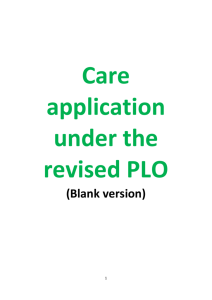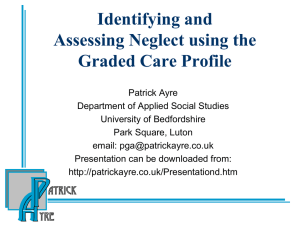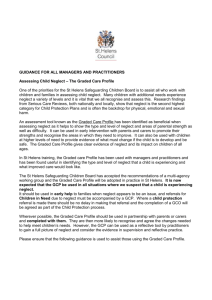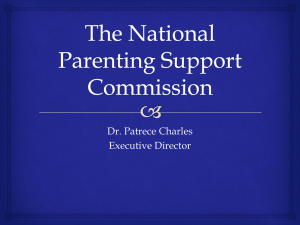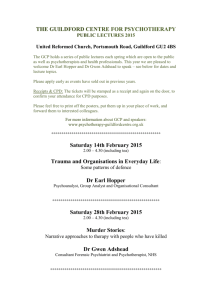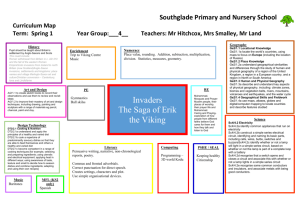Solution Focused Interventions in Neglect
advertisement
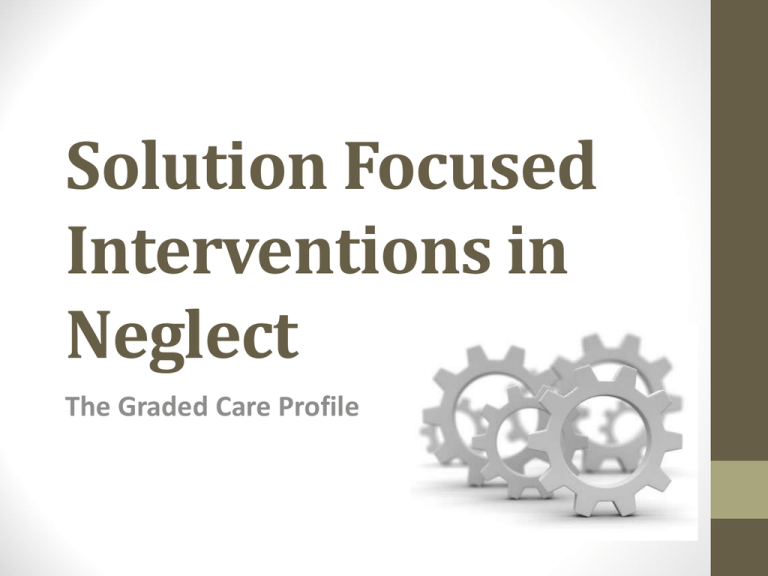
Solution Focused Interventions in Neglect The Graded Care Profile Aims and Objectives • To enable participants to have working knowledge of GCP • To support participants to quantify neglect by use of a working tool to use together with service users • To enhance or enable communication between professionals and service users • To offer a guide to identify a programmed plan of care and setting of achievable targets, for professionals and service users • To have an awareness and understanding of how the GCP is used to support the legislation in regards to safeguarding children. Introducing a More Objective Measure of Care • Judging the quality of care is an essential component of any assessment but how well do we do it? • Judgements are subjective and prone to bias • Intangible: Difficult to capture and compare • High threshold for recognition • Cumulativeness and acclimatisation The Graded Care Profile • The Graded Care Profile (GCP) scale was developed as a practical tool in response to the Children Act 1989 to provide a measure of care in four domains or areas: Physical, Safety, Love, and Esteem, on a bipolar continuum. • It is seen as providing practitioners with a common tool or frame of reference to aid informed assessment of care & neglect “Every Child Has a Right to Good Enough Parenting” The GCP Provides: • A Shared Framework for Assessment/Intervention • A Reliable Standardised Evidence Base • A Baseline Measurement Tool • A Common Measure of Objectivity • A Framework in Which to Make Judgements about Care – Highlighting Areas of Strength & Concern • Opportunity to Highlight Areas not Always Apparent Cross Discipline Assessment Tool • Pre-referral assessments • Snapshot assessment • Contribution to Core Assessments /Integrated Assessment (parenting capacity) • Monitoring assessments • Self assessments – parents / carers • Young peoples assessments of parents / carers • Identification of areas of strength & weakness • Tool for setting goals for parenting • Tool to facilitate discussion User Friendly The Graded Care Profile is an assessment tool that can be used in all cases including the following user groups • – Parents with learning disabilities • – Physical disabilities • – Parents with Dependency Issues – Drugs/Alcohol • – Adult Mental health • – Different cultural and ethnic backgrounds Differentiates Care ..... • Between different carers • Provides better evidence Good enough parenting Good Enough” parents show pride and pleasure in their child’s progress together with many other positive emotions such as affection, tenderness, interest, delight and many others, which will increase the child’s self-confidence and self-esteem. There are also, at times, negative, feelings towards their children such as frustration, fatigue, anger boredom, anxiety, fear, disappointment and many others, which parents learn to accept as normal when occurring only occasionally. Professionals need understanding and awareness of when the negative feelings are becoming excessive and when they may swamp the positive ones. When to Use the Graded Care Profile • Concerns regarding Parenting • Child Exhibiting Problems • Children in Need • Children in Need of Protection • Programme of Intervention • Any Other Concerns Promotes Greater Objectivity • 1. Parenting Strength Child focused • 2. Based on developmental outcomes Not opinions • 3. No extrapolation Based on actual observations • 4. Captures negative & positive care Bipolar continuum • Common language, common reference • Objective measure – child focussed • Effective tool to promote partnership assessments and planning with parents • User friendly • Covers all areas of care • Child and carer specific Domains of Care (Maslow 1954) Derived from Maslow’s Hierarchy of Needs but more specific to compel holistic approach to assessment & remove generalised commentary. Self Actualisation Care of ESTEEM Care of LOVE and belongingness Care of SAFETY Care of PHYSICAL needs The categorisation of different grades of care Grade 1 Grade 2 Grade 3 Grade 3 Grade 4 1. Level of Care All child’s needs met Essential needs fully met Some essential needs unmet Most essential needs unmet Essential needs entirely unmet/ hostile 2.Commit ment of Care Child is First Child is a priority Child and parents needs on par Child is secondary Child is not considered Adequate Equivocal Poor Worse 3 Quality of Good Care What to observe……. PHYSICAL SAFETY LOVE ESTEEM Nutrition Housing Clothing Hygiene Health Quality Quantity Preparation Organisation Sub areas 1 2 3 4 5 A Quality Aware and proactive; provides excellent quality food and drink. Aware and manages to provide reasonable quality food and drink. Provision of reasonable quality food inconsistent through lack of awareness or effort. Provision of poor quality food through lack of effort; only occasionally of reasonable quality if pressurised Quality not a considerate on at all or lies about quality. B Quantity Ample Adequate Variable Low Starved C Preparation Painstakingly cooked/prepared for the child. Well prepared for the family always accommodating child’s need, sometimes for the child. Preparation infrequent and mainly for the adults, child sometimes accommodated. More often no preparation . If there is, child’s need or taste not accommodated. Hardly ever any preparation. Child lives on snacks/cereals. D Organisation Meals elaborately organised – seating, timing, manners. Well organised often seating, regular timing. Poorly organised irregular timing, improper seating. Not organised no clear meal time. Chaotic – eat when and what one can. NUTRITION SCORING • 4 AREAS (A, B, C & D) – Physical, Safety, Love & Esteem • SUB-AREAS (up to 5 in each Area) • Each Sub Area is scored from 1 - 5 • Use on Every Child in the Family • Use with Primary Carer/s & Different Carers • Make sure information is as factual as possible • Draw on Information, Observation & Records • Complete the full reference scheme • Transpose to the record sheet • Obtaining a score for a sub-area from score in its items • Between 1 and 3, when there are more of one score, record the one with the most. If there is an even split, the highest score is entered • However If there is even a single score above point 3, score that point regardless of mode. / average. • If there is a score of 4 or 5, go with highest score Positives of the GCP • Embraces numerous presenting concerns in adult behaviour (such as domestic violence, mental health problems or substance misuse problems) • Use as referral, initial, core assessment and court tool • Supports core assessment tool • Links to conference requirements and core group planning • Retrospective application possible • Clarification with criminal justice system about threshold for police investigation and prosecution via crossing public interest threshold • Engagement of adult services • Use across all families (birth, foster and extended) • Links across prevention and protection • Links with existing tools across agencies such as percentiles • Supports links across information collection, analysis and planning • It is evidence-based (linking theory, research and practice wisdom) • Links to model of change • Common language • Potential to engage • Identifies strengths and weaknesses • Allows children to understand own experiences and challenge parents • Holistic focus to contextualise concern (e.g. dirty child or house) • Picks up patterns of concern over time • Links to Assessment Framework Negatives • Not useful as a child protection tool but can help analyse and contextualise information collected • Potentially deskilling • Language alienation • Focus is younger children rather than adolescents • Does not address unborn children • Unusable unless adopted by inter-agency system • Does not negate the need for parallel assessments on the origins of parental behaviour (domestic violence, mental health, substance misuse) • Links with emotional abuse and boundary issues between emotional abuse and neglect needed • Does not negate the need to use circumstance specific assessment tools e.g. failure to thrive
